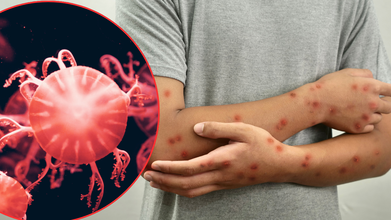- Health Conditions A-Z
- Health & Wellness
- Nutrition
- Fitness
- Health News
- Ayurveda
- Videos
- Medicine A-Z
- Parenting
- Web Stories
Over 1 In 3 COVID Cases In US Now Are Because Of New ‘Nimbus’ Variant: Experts Flag This Painful Symptom

As the U.S. gears up for the peak summer travel season, a new COVID-19 variant known as NB.1.8.1—or informally, "Nimbus" has rapidly taken center stage in the ongoing pandemic landscape. First identified through international traveler screening in March 2025, the highly contagious Omicron subvariant is now responsible for an estimated 37% of COVID-19 cases in the country, according to the CDC’s latest two-week analysis ending June 7.
NB.1.8.1 is a descendant of the Omicron recombinant lineage XDV.1.5.1 and possesses several spike protein mutations that have the potential to make it more transmissible and immune-evading with respect to immunity developed from prior infections or vaccinations. Nicknamed "Nimbus" by Canadian evolutionary biologist T. Ryan Gregory, the moniker has picked up steam on social media and public health discourse.
Although total test positivity is still relatively low in the U.S. at approximately 3%, the swift rise of Nimbus to become the second most prevalent variant—second only to LP.8.1 at 38%—has raised alarm among virologists and public health professionals. Although present infection and hospitalization levels are still within control, experts are warning of the possibility of a summer spike akin to cycles experienced in earlier years.
What Are The Painful Tell-Tale Symptoms of New Covid Variant?
One of the clearest indicators of the NB.1.8.1 strain is a symptom described by patients as a "razor blade feeling" in the throat. This sore throat—dull and stabbing particularly when swallowing—is reported more often among Nimbus sufferers than in previous strains. Specialists advise rest, hydration, and painkillers to treat this symptom.
Other frequently reported symptoms are fatigue, nasal congestion, cough, fever, muscle pain, and mild breathing difficulties, in line with previous Omicron subvariants.
On May 23, the World Health Organization designated NB.1.8.1 as a "variant under monitoring," noting its rapid worldwide spread and potentially high mutations. As of May 18, it was reported in more than 22 nations and now accounts for more than 10.7% of cases of COVID-19 worldwide.
In the United States, sequences deposited at GISAID corroborate its presence in at least 14 states, with public health officials anticipating wider geographic spread over the next few weeks. Trends from foreign health agencies and increasing hospitalizations in the U.K. imply a worldwide trend of enhanced transmissibility despite incomplete sequencing data.
How Dangerous Is Nimbus COVID Variant?
Although Nimbus is certainly more infectious, to date, there is no indication that it produces more severe illness than the previous ones. The WHO and the CDC both confirm that authorized COVID-19 vaccines continue to work against this variant, although breakthrough infections may happen.
The United Kingdom Health Security Agency (UKHSA) recently posted a near 10% increase in COVID hospitalizations and a 6.9% rise in cases in one week. UKHSA's deputy director, Dr. Gayatri Amirthalingam, stressed the point that while the variant is spreading, there is no immediate evidence of heightened severity of disease.
Will Nimbus Lead to a U.S. Summer Surge?
In the past, COVID-19 has increased twice a year in the United States—in the winter and then in the summer months, from June through August. That has been the case since 2020, and having a new, more contagious variant coupled with more travel and gatherings could set off another wave.
Experts warn that while population immunity in the U.S. is very high—with more than 90% of Americans having been infected or vaccinated—immunity does fade over time. Couple this with the immune-evasive nature of NB.1.8.1, and the recipe for a possible surge in cases is there.
Presently, WHO claims that current vaccines are protective against Nimbus. New COVID vaccines for the 2025–2026 season, designed to address LP.8.1, are set to be distributed this fall. In a contentious decision, Health and Human Services Secretary Robert F. Kennedy Jr. stated that the vaccines will only be available for high-risk populations: persons above 65 years and persons between the ages of 12–64 with at least one comorbidity.
The CDC has also at the same time revised its guidelines, no longer advising routine COVID vaccination of healthy pregnant women and children—a step that most obstetricians and pediatricians object to.
How Can You Stay Safe?
With COVID wastewater levels still low and hospitalization rates stable, there is no need for mass panic. However, staying informed and cautious is key. Individuals experiencing symptoms like razor-sharp throat pain, fever, or congestion should consider testing, isolate if positive, and seek medical attention if symptoms worsen—especially if they belong to high-risk groups.
Visitors are urged to watch for regional strain patterns, maintain proper hygiene, and wear masks in crowded or poorly ventilated spaces during peak travel seasons.
NB.1.8.1, or the "Nimbus" strain, is another chapter in the continuing COVID-19 tale. Although it seems no worse than past strains, its speed and its sore, razor-like throat mark it as a reminder that the virus is still evolving.
Public health officials emphasize that vaccines continue to provide robust protection and must be employed as a first line of defense, particularly among those who are most vulnerable. While summer progresses, the emergence of Nimbus necessitates close observation, public awareness, and redoubled focus on preventive health.
A Severe Mpox Strain Is Spreading in the US, Here’s What You Need to Know to Stay Safe

Credits: Canva
Health officials in the United States have raised alarms after confirming cases of a more severe mpox strain, known as Clade I, in California. This marks the first reported instance of this strain spreading locally, as previous US cases had all been linked to international travel.
So far, three cases have been confirmed across Southern California, including Los Angeles County and Long Beach. All patients required hospitalization but are now recovering at home. The discovery has triggered concern among health experts as Clade I mpox is known to cause more serious illness than the milder Clade II strain that led to the 2022 global outbreak.
What Is Clade I Mpox?
Mpox (formerly called monkeypox) is caused by a virus from the same family as smallpox. There are two main genetic variants or clades that infect humans, Clade I and Clade II.
While Clade II was responsible for the global outbreak in 2022–23, Clade I has historically circulated in parts of central and western Africa. It is associated with more severe disease, higher rates of complications, and in some cases, fatalities, particularly among children, pregnant women, and people with weakened immune systems.
Experts are now investigating how this strain might have started circulating within US borders and whether community transmission is occurring.
Early Signs and Symptoms to Watch For
Mpox usually begins with flu-like symptoms and can be easily mistaken for a seasonal illness in its early stages. Common early signs include:
- Fever, chills, or sweating
- Headache and muscle aches
- Fatigue or weakness
- Swollen lymph nodes
- Sore throat or nasal congestion
Within a few days, a distinctive rash develops, starting as red spots that progress into fluid-filled blisters or pustules. These can appear on the face, palms, soles, genitals, or even inside the mouth and eyes. The rash typically scabs over and heals within two to four weeks.
In more severe Clade I infections, complications may include secondary bacterial infections, prolonged healing, scarring, eye involvement leading to blindness, or inflammation of internal organs. In rare cases, systemic infection can occur, posing life-threatening risks.
Who Is Most at Risk?
Certain groups are more likely to contract or develop severe mpox:
- Those in close, intimate, or prolonged contact with an infected person
- Individuals who share contaminated clothing, bedding, or surfaces
- People exposed to respiratory droplets through face-to-face interaction
- Individuals with multiple sexual partners or exposure in commercial sexual venues
- People with compromised immunity, such as those living with HIV, cancer, or transplant recipients
Children and pregnant women
Public health experts emphasize that awareness of symptoms and early diagnosis are key to preventing further spread.
How to Stay Safe
While most mpox cases are not fatal, Clade I poses a higher risk, making prevention critical. Health agencies recommend the following:
- Avoid direct contact with people who have rashes or lesions resembling mpox.
- Do not share personal items like towels, bedding, or clothing.
- Practice good hand hygiene, wash hands often with soap and water or use an alcohol-based sanitizer.
- Use masks in crowded or high-risk settings where close contact occurs.
- Seek medical attention immediately if you notice suspicious rashes or flu-like symptoms after possible exposure.
Experts also stress that vaccines used during the 2022 outbreak, such as Jynneos, remain effective against both Clade I and Clade II strains. Vaccination, combined with early treatment and isolation of confirmed cases, is expected to play a crucial role in containing the spread.
First Locally Acquired Clade 1 Mpox Case Detected California, Symptoms You Should Look Out For

(Credit-Canva)
The Long Beach Department of Health and Human Services has confirmed its first case of locally acquired Clade-1 Monkeypox strain. In a recent press release, the authorities informed the citizens that the person who was diagnosed had no recent travel history, which means the virus was contracted locally.
While the risk for the public remains low, the health department warns people to stay safe. Since it is a contagious disease, the health investigation is still ongoing, as the public officers comb through the person’s history. However, currently there are no other cases of the clade 1 mpox. Mayor Rex Richardson said, “While the overall risk of mpox clade I exposure to the public remains low, we are taking this very seriously and ensuring our community and health care partners remain vigilant so we can prevent any more cases.”
What Is Mpox?
According to the World Health Organization, Mpox (previously called monkeypox) is a sickness caused by a virus. Think of it as being like different types of flu—there are a few versions of the mpox virus, called clades.
The global outbreak that happened in 2022–2023 was caused by one of these versions, specifically Clade IIb. The virus spreads through close contact with an infected person's sores or body fluids, with contaminated items like bedding, or with infected animals. The virus can also be passed from a pregnant person to their baby.
Most mpox treatment involves supportive care—doctors help manage symptoms like pain and fever while the body recovers. This includes keeping the patient well-nourished and hydrated, caring for the rash, and addressing any secondary infections. Fortunately, vaccines are available for mpox.
How is Clade 1 Different From Clade 2?
This new case involves Clade 1 mpox, which is historically associated with more severe illness and is typically found in Central and East Africa.
In contrast, the large 2022-2023 outbreak in the U.S. and globally was caused by Clade 2, which usually results in milder illness. Mpox, regardless of the clade, spreads through direct contact with sores, body fluids, intimate contact, or contaminated items. Symptoms can include a rash or sores, fever, chills, sore throat, swollen lymph nodes, and body aches.
What Are The Health Risks of Mpox?
Long Beach health officials are currently investigating the patient's source of exposure and conducting contact tracing, though no other cases have been identified so far.
Long Beach Mayor Rex Richardson emphasized that while the overall risk to the public remains low, the city is taking the situation seriously. He stressed the importance of continued surveillance, early response, and vaccination.
A Long Beach public health physician, Dr. Cliff Okada, advised: "Anyone with an unexplained rash or lesions should seek care promptly. Speak openly with intimate partners and your healthcare provider. Early action protects you and others."
Who Is At Risk For Mpox Clade 1?
The Centers for Disease Control and Prevention (CDC) continues to recommend the Jynneos vaccine for people at high risk of exposure. This includes gay, bisexual, and other men who are intimately involved with other men, transgender and non-binary people, those with weakened immune systems (such as people with HIV), individuals exposed to an infected person, those with occupational exposure, and people traveling to areas with ongoing outbreaks.
Most mpox patients recover on their own within 2 to 4 weeks. A booster shot is not currently recommended for those who have completed the two-dose vaccine series.
Liam Payne’s Girlfriend Kate Cassidy Opens Up About Her Depression Following Singer’s Death

Credits: Canva
Liam Payne's death marks a whole year, and his girlfriend Kate Cassidy reflected on his death anniversary. She also opened up about her depression after his death. Cassidy lost her boyfriend, former One Direction member in 2024, and as she said, her world collapsed.
The 26-year-old social media star has now opened up about her painful journey through grief, depression, and eventually healing.
In an interview to Page Six, she said, "I was always just kind of doing nothing and just dealing with that grief and pain. I was admittedly mired in depression and just not wanting to really live my life.”
For weeks, Cassidy found herself unable to function, trapped between disbelief and heartbreak. But around two months later, something shifted.
“I finally realized, ‘OK, like I need to live my life. I need to get up, get out of bed,’” she recalled.
The Way To Healing
However, she was determined to pull herself out of darkness and so she began to rebuild her days, one small habit at a time. She started to set her alarm earlier each morning, forcing herself to wake up and move. "I began working out, eating clean," she said. "I like to always be up early, have a workout class planned, go for a nice walk, eat cleaner. For me, being active always keep my mind so much cleaner and healthier," she explained.
Gradually, she also learned to navigate her life without Payne, and kept herself busy. She said that she tried to be as busy as she can to help her headspace.
Also Read: Liam Payne Investigation: How Pink Cocaine Affects You?
Acknowledging The Hard Truth
Payne's death was a devastating news for her as well as for her fans. The 31-year-old singer died in October 2024, after falling from a third-storey balcony at the CasaSur Palermo Hotel in Buenos Aries, Argentina.
An autopsy report later revealed that Payne had drugs in his system and the authorities determined that he fell to his death while trying to escape the hotel room after he was locked in.
Cassidy had joined Payne on the trip, but returned home two days before his death. Following his death, she revealed that they had talked about spending their lives together. "We had so many plans. He lit up my room. He was just so sweet, so funny. I've never met anybody like him and I'm sure I probably won't ever meet anybody like him in my life."
Almost a year later, Cassidy is filled with both sorrow and gratitude. "In a way, I am glad that he is going to be that one person. He was the best person I ever met."
Cassidy said that through grief she is learning to embrace life again.
What Depression Feels Like After You Lose Someone
Cassidy opened up that right after losing Payne, she felt like she could not live anymore. While grief and loss is a natural emotional response to the loss of someone close, often, one slips through depression, if they are not able to cope with the loss.
Depression is a mood disorder and it causes a persistent feeling of sadness, and further affects your emotional and physical well-being.
NHS UK notes that people who deal with grief and loss feel shock and first and numb after and then they go into the phase of overwhelming sadness, tiredness, exhaustion, and sometimes anger.
However, there are things one can do, notes NHS UK, which includes talking to a friend, a mental health expert, go for peer support, and try to bring in simple lifestyle changes to help you feel more in control and able to cope.
© 2024 Bennett, Coleman & Company Limited

